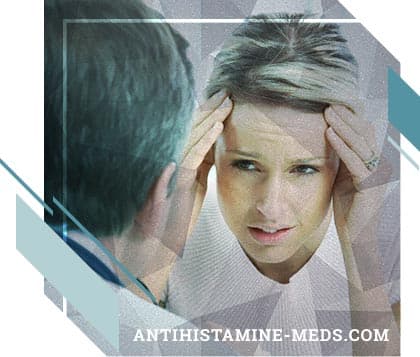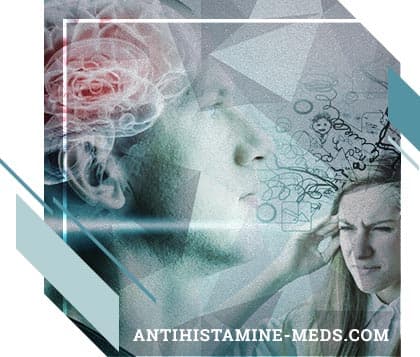General and clinical characteristics
Somatogenic mental illness is a combined group of mental disorders resulting from somatic noncommunicable diseases. These include mental disorders in cardiovascular, gastrointestinal, renal, endocrine, metabolic and other diseases. Mental disorders of vascular origin (with hypertension, arterial hypotension and atherosclerosis) are traditionally allocated as an independent group.

Classification of somatogenic mental disorders
1. Borderline nonpsychotic disorders:
- asthenic, neurosis-like conditions caused by somatic non-infectious diseases (code 300.94), metabolic, growth and nutritional disorders;
- non-psychotic depressive disorders caused by somatic non-infectious diseases (311.4), metabolic, growth and nutritional disorders, other and unspecified organic brain diseases;
- neurosis and psychopathic disorders due to somatogenic organic lesions of the brain.
2. Psychotic conditions developed as a result of functional or organic brain damage:
- acute psychoses - asthenic confusion, delirious, amentia and other syndromes of stupefaction;
- subacute protracted psychoses - paranoid, depressive-paranoid, anxiety-paranoid, hallucinatory-paranoid, catatonic and other syndromes;
- chronic psychoses - Korsakovsky syndrome, hallucinatory-paranoid, senestopathic-hypochondriac, verbal hallucinosis, etc.).
3. Defective organic conditions:
- a simple psycho-organic syndrome;
- Korsakovsky syndrome;
- dementia.
Somatic diseases acquire an independent significance in the occurrence of a disorder of mental activity, in relation to which they are an exogenous factor. The mechanisms of brain hypoxia, intoxication, metabolic disorders, neuroreflexive, immune, autoimmune reactions are important. On the other hand, as B. A. Tselibeev (1972) noted, somatogenic psychoses cannot be understood only as a result of somatic disease. In their development, a predisposition to the psychopathological type of response, psychological characteristics of the personality, and psychogenic influences play a role.
The problem of somatogenic mental pathology is becoming increasingly important in connection with the growth of cardiovascular pathology. Pathomorphism of mental diseases is manifested by the so-called somatization, the prevalence of nonpsychotic disorders over psychotic, "bodily" symptoms over psychopathological ones. Patients with sluggish, "erased" forms of psychosis sometimes end up in general somatic hospitals, and severe forms of somatic diseases are often unrecognized due to the fact that subjective manifestations of the disease "overlap" objective somatic symptoms.
Mental disorders are observed in acute short-term, protracted and chronic somatic diseases. They are manifested in the form of nonpsychotic (asthenic, asthenodenressive, asthenodystimic, astenoipochondria, anxiety-phobic, hysteriform), psychotic (delirious, delirious-amenitic, onyric, twilight, catatonic, hallucinatory-deranoorganic, organo-organisms).
According to V. A. Romasenko and K. A. Skvortsov (1961), B. A. Tselibeyev (1972), A. K. Dobrzhansky (1973), the exogenous nature of mental disorders of nonspecific tin is usually observed in acute course of somatic disease. In cases of its chronic course with diffuse brain damage of a toxico-anoxic nature more often than with infections, there is a tendency toward psychopathological symptomatology endoform.
Mental disorders in certain somatic diseases
Mental disorders in heart disease
One of the most commonly detected forms of heart damage is coronary heart disease (CHD). In accordance with the WHO classification, IHD includes angina pectoris of tension and rest, acute focal myocardial dystrophy, small and large focal myocardial infarction. Coronary-cerebral disorders are always combined. With heart diseases, cerebral hypoxia is noted, with lesions of the cerebral vessels, hypoxic changes in the heart are detected.
Mental disorders resulting from acute heart failure can be expressed by syndromes of impaired consciousness, most often in the form of stupor and delirium, characterized by instability of hallucinatory experiences.
Mental disorders in myocardial infarction have been systematically studied in recent decades (I. G. Ravkin, 1957, 1959; L. G. Ursova, 1967, 1969). Depressive states, syndromes of impaired consciousness with psychomotor agitation, euphoria are described. Overvalued formations are often formed. With small-focal myocardial infarction, severe asthenic syndrome develops with tearfulness, general weakness, sometimes nausea, chills, tachycardia, low-grade body temperature. With a large focal heart attack with damage to the anterior wall of the left ventricle, anxiety, fear of death; with a heart attack of the posterior wall of the left ventricle, euphoria, persistence, lack of criticism of one's condition with attempts to get out of bed, asking for some work are observed. In a post-infarction state, lethargy, severe fatigue, hypochondria are noted. Often a phobic syndrome develops - expectation of pain, fear of a repeated heart attack, getting out of bed at a time when doctors recommend an active regimen.
Mental disorders also occur with heart defects, as indicated by V. M. Banshchikov, I. S. Romanova (1961), G. V. Morozov, M. S. Lebedinsky (1972). With rheumatic heart diseases V.V. Kovalev (1974) identified the following options for mental disorders:
- borderline (asthenic), neurosis-like (neurasthenoid-like) with vegetative disturbances, cerebrosteic with mild manifestations of organic cerebral insufficiency, euphoric or depressive-dysthymic mood, hysteriform, astenoinchondria states; neurotic reactions of the depressive, depressive-hypochondriacal and pseudo-euphoric types; pathological personality development (psychopathic);
- psychotic (cardiogenic psychoses) - acute with delirious or amenable symptoms and subacute, protracted (anxiety-depressive, depressive-paranoid, hallucinatory-paranoid); 3) encephalopathic c (psycho-organic) - psycho-organic, epileptiform and Corsacan syndromes. Congenital heart defects are often accompanied by signs of psychophysical infantilism, asthenic, neurosis and psychopathic conditions, neurotic reactions, and mental retardation.
Currently, heart surgery is widely performed. Surgeons and cardiologists-therapists note a disproportion between the objective physical capabilities of the operated patients and the relatively low actual indicators of rehabilitation of people who underwent heart surgery (E.I. Chazov, 1975; N.M. Amosov et al., 1980; S. Bernard, 1968 ) One of the most significant causes of this imbalance is the psychological maladaptation of people who underwent heart surgery. When examining patients about the pathology of the cardiovascular system, they established the presence of pronounced forms of personality reactions (G.V. Morozov, M.S. Lebedinsky, 1972; A.M. Wayne et al., 1974). N.K. Bogolepov (1938), L.O. Badalyan (1963), V.V. Mikheev (1979) indicate a high frequency of these disorders (70-100%). Changes in the nervous system in heart defects were described by L.O. Badalyan (1973, 1976). Circulatory failure arising from heart defects leads to chronic brain hypoxia, the occurrence of cerebral and focal neurological symptoms, including in the form of convulsive seizures.
Patients operated on for rheumatic heart diseases usually have complaints of headache, dizziness, insomnia, numbness and cooling of the extremities, pain in the heart and behind the sternum, asphyxiation, rapid fatigability, shortness of breath, aggravated by physical exertion, weakness of convergence, decrease corneal reflexes, muscle hypotension, decreased periosteal and tendon reflexes, impaired consciousness, more often in the form of fainting, indicating a violation of blood circulation in the system of vertebral and basilar arteries and basin of the internal carotid artery.
Mental disorders that occur after cardiac surgery are a consequence of not only cerebrovascular disorders, but also a personality reaction. V. A. Skumin (1978, 1980) identified "cardioprosthetic psychopathological syndrome", which often occurs during mitral valve implantation or multi-valve prosthetics. Due to the noise phenomena associated with the activity of the artificial valve, impaired receptive fields at the site of its implantation, and heart rhythm disturbance, the attention of patients is riveted to the work of the heart. They have concerns and fears about a possible "valve opening", its breakdown. A depressed mood intensifies by night, when the noise from the operation of artificial valves is heard especially clearly. Only in the afternoon, when the patient is seen by medical personnel, can he fall asleep. A negative attitude to active activity is developed, an alarming and depressive mood background with the possibility of suicidal actions arises.

In V. Kovalev (1974) in the uninformed postoperative period, he noted astenoadynamic conditions in patients, sensitivity, transient or persistent intellectual and memetic insufficiency. After operations with somatic complications, acute psychoses often occur with stupefaction (delirious, delirious amenitic and delirious opeiroid syndromes), subacute abortive and protracted psychoses (anxiety-depressive, depressive-hypochondriac, depressive-paranoid epileptic syndromes).
Mental disorders in patients with renal pathology
Mental disorders in renal pathology are observed in 20-25% of diseased people (V. G. Vogralik, 1948), but not all of them fall into the field of vision of psychiatrists (A. G. Naku, G. N. German, 1981). Marked mental disorders developing after kidney transplantation and hemodialysis are noted. A. G. Naku and G. N. German (1981) distinguished typical nephrogenic and atypical nephrogenic psychoses with the obligatory presence of an asthenic background. The authors include asthenia, psychotic and nonpsychotic forms of upset consciousness in the 1st group, and endoform and organic psychotic syndromes in the 2nd group (we consider the inclusion of asthenia syndromes and nonpsychotic disturbance of consciousness in the composition of psychotic states to be erroneous).
Asthenia with renal pathology, as a rule, precedes the diagnosis of kidney damage. There are unpleasant sensations in the body, a "stale head", especially in the mornings, nightmares, difficulty concentrating, a feeling of weakness, depressed mood, somatoneurological manifestations (coated tongue, grayish-pale complexion, instability of blood pressure, chills and profuse sweating on at night, unpleasant sensation in the lower back).
Asthenic nephrogenic symptom complex is characterized by a constant complication and increase in symptoms, up to a state of asthenic confusion, in which patients do not catch changes in the situation, do not notice the objects they need next to them. With an increase in renal failure, the asthenic state can be replaced by amentia. A characteristic feature of nephrogenic asthenia is adynamia with the impossibility or difficulty of mobilizing oneself to perform an action while understanding the need for such mobilization. Patients spend most of their time in bed, which is not always justified by the severity of renal pathology. According to A.G. Naku and G.N. German (1981), the frequently observed change in astheno-dynamic states as asthenosubdepressive is an indicator of the patient's somatic state improvement, a sign of "affective activation", although it goes through a pronounced stage of a depressive state with ideas of self-abasement (unnecessary, worthlessness, family burdens).
Syndromes of confused consciousness in the form of delirium and amentia with nephropathy are difficult, patients often die. Two variants of amenable syndrome are distinguished (A. G. Maku, G. II. German, 1981), which reflect the severity of renal pathology and have prognostic significance: hyperkinetic, in which uremic intoxication is not clearly expressed, and hypokinetic with increasing decompensation of renal activity, a sharp increase in arterial pressure.
Severe forms of uremia are sometimes accompanied by psychosis of the type of acute delirium and end in death after a period of being stunned by a sharp motor anxiety, fragmentary delusions. When the state worsens, the productive forms of frustrated consciousness are replaced by unproductive ones; adynamia and somnolence increase.
Psychotic disorders in the case of protracted and chronic kidney diseases are manifested by complex syndromes observed against asthenia: anxiety-depressive, depressive and hallucinatory-paranoid and catatonic. The increase in uremic toxicosis is accompanied by episodes of psychotic stupefaction, signs of organic damage to the central nervous system, epileptiform paroxysms and intellectual and mnestic disorders.
According to B. A. Lebedev (1979), in 33% of the examined patients against the background of severe asthenia, mental reactions of depressive and hysterical types are noted, in the rest - an adequate assessment of their condition with a decrease in mood, understanding of the possible outcome. Asthenia can often inhibit the development of neurotic reactions. Sometimes in cases of insignificant severity of asthenic symptoms, hysterical reactions occur that disappear with an increase in the severity of the disease.
A rheoencephalographic examination of patients with chronic kidney diseases makes it possible to detect a decrease in vascular tone with a slight decrease in their elasticity and signs of impaired venous current, which are manifested by an increase in the venous wave (presystolic) at the end of the catacrotic phase and are observed in people suffering from arterial hypertension for a long time. Instability of vascular tone is characteristic, mainly in the system of vertebral and basilar arteries. In mild forms of kidney disease, there is no marked deviation from the norm in pulse blood filling (L. V. Pletneva, 1979).
In the late stages of chronic renal failure and with severe intoxication, organ-substituting operations and hemodialysis are performed. After a kidney transplant and during dialysis stable suburemia, chronic nephrogenic toxicodyshomeostatic encephalopathy is observed (M. A. Tsivilko et al., 1979). Patients have weakness, sleep disturbances, mood depression, sometimes a rapid increase in adynamia, stupor, convulsive seizures appear. It is believed that syndromes of clouded consciousness (delirium, amentia) arise due to vascular disorders and postoperative asthenia, and syndromes of turning off consciousness as a result of uremic intoxication. In the process of hemodialysis treatment, there are cases of intellectual-mnestic disorders, organic brain damage with a gradual increase in lethargy, loss of interest in the environment. With prolonged use of dialysis, a psycho-organic syndrome develops - "dialysis-uremic dementia", which is characterized by deep asthenia.
When a kidney transplant is used, large doses of hormones are used, which can lead to disorders of autonomic regulation. In the period of acute transplant failure, when azotemia reaches 32.1-33.6 mmol, and hyperkalemia reaches 7.0 meq / l, hemorrhagic phenomena (profuse nosebleeds and hemorrhagic rashes), paresis, and paralysis can occur. An electroencephalographic study reveals persistent desynchronization with an almost complete disappearance of alpha activity and the predominance of slow-wave activity. When rheoencephalographic research reveals pronounced changes in vascular tone: uneven waves in shape and size, additional venous waves. The asthenia sharply amplifies, subcomatous and coma states develop.
Mental disorders in diseases of the digestive tract
Digestive diseases take the second place in the general morbidity of the population, second only to cardiovascular pathology.
Violations of the mental functions of the pathology of the digestive tract are more often limited to sharpening characterological features, asthenic syndrome, and neurosis-like conditions. Gastritis, peptic ulcer and nonspecific colitis are accompanied by exhaustion of mental functions, sensitivity, lability or torpidity of emotional reactions, anger, a tendency to hypochondriac interpretation of the disease, carcinophobia. With gastro-esophageal reflux, neurotic disorders (neurasthenic syndrome and obsessive phenomena) are observed, preceding the symptoms of the digestive tract. Claims of patients about the possibility of a malignant neoplasm are noted in the framework of overvalued hypochondria and paranoia. Complaints of memory impairment are associated with a disorder of attention due to both fixation on the sensations caused by the underlying disease and a depressive mood.
A complication of gastric resection in peptic ulcer disease is dumping syndrome, which should be delimited from hysterical disorders. Under the dumping syndrome is understood vegetative crises that are paroxysmally arising as hypo- or hyperglycemic immediately after eating or after 20-30 minutes, sometimes 1-2 hours.
Hyperglycemic crises appear after eating hot food containing easily digestible carbohydrates. Suddenly, a headache occurs with dizziness, tinnitus, less often - vomiting, drowsiness, tremor. "Black dots", "flies" in front of the eyes, disturbances in body patterns, instability, and fluctuation of objects may appear. They end with excessive urination, drowsiness. At the height of the attack, sugar levels and blood pressure increase.
Hypoglycemic crises occur outside of food intake: weakness, sweating, headache, dizziness appear. After eating, they quickly stop. During a crisis, blood sugar levels decrease, and a drop in blood pressure is observed. Possible disturbances of consciousness at the height of the crisis. Sometimes crises develop in the morning after sleep (R. E. Halperina, 1969). In the absence of timely therapeutic correction, hysterical fixation of this condition is not excluded.
Cancer Mental Disorders
The clinical picture of brain tumors is determined by their localization. With the growth of the tumor, cerebral symptoms are more prominent. Almost all types of psychopathological syndromes are observed, including asthenic, psycho-organic, paranoid, hallucinatory-paranoid (A. S. Shmaryan, 1949; I. Ya. Razdolsky, 1954; A. L. Abashev-Konstantinovsky, 1973). Sometimes a brain tumor is detected in sections of deceased persons treated for schizophrenia and epilepsy.
In malignant neoplasms of extracranial localization, V. A. Romasenko and K. A. Skvortsov (1961) noted the dependence of mental disorders on the stage of the course of cancer. In the initial period, sharpening of the characterological features of patients, neurotic reactions, asthenic phenomena are observed. In the expanded phase, asthenodepressive conditions and anosognosia are most often observed. With cancer of the internal organs in the manifest and predominantly terminal stages, there are states of "silent delirium" with adynamia, episodes of delirious and onyric experiences, followed by stupor or bouts of arousal with fragmentary delusional statements; delirious amentive states; paranoid states with delusions of attitude, poisoning, damage; depressive states with depersonalization phenomena, senestopathies; reactive hysterical psychoses. Instability, dynamism, and a frequent change in psychotic syndromes are characteristic. In the terminal stage, oppression of consciousness (stupor, stupor, coma) gradually increases.
Articles
Postpartum Mental Disorders
There are four groups of psychoses that arise in connection with childbirth:
- generic;
- the actual postpartum;
- psychoses of the lactation period;
- endogenous psychoses provoked by childbirth.
The mental pathology of the postpartum period does not represent an independent nosological form. Common to the whole group of psychoses is the situation in which they arise.
Generic psychoses are psychogenic reactions that develop, as a rule, in primiparous women. They are caused by fear of expectation of pain, an unknown, frightening event. At the first signs of a beginning labor, some women in labor may develop a neurotic or psychotic reaction, in which, against the background of a narrowed consciousness, hysterical crying, laughter, screaming, sometimes fugiform reactions, and less often hysterical mutism, appear. Women in labor refuse to follow the instructions offered by the medical staff. The duration of the reaction is from several minutes to 0.5 hours, sometimes longer.
Postpartum psychoses are conditionally divided into actually postpartum and psychoses of the lactation period.
Actually postpartum psychoses develop during the first 1-6 weeks after birth, often in the maternity hospital. The causes of their occurrence: toxicosis of the second half of pregnancy, a difficult birth with massive tissue trauma, delayed separation of the placenta, bleeding, endometritis, mastitis, etc. A decisive role in their appearance belongs to a birth infection, the predisposing moment is toxicosis of the second half of pregnancy. At the same time, psychoses are observed, the occurrence of which cannot be explained by postpartum infection. The main reasons for their development are trauma to the birth canal, intoxication, neuroreflexive and psychotraumatic factors in their entirety. Actually postpartum psychoses are more often observed in primiparous women. The number of sick women who gave birth to boys is almost 2 times more than women who gave birth to girls.
Psychopathological symptoms are characterized by an acute onset, occurs after 2-3 weeks, and sometimes 2-3 days after birth against a background of increased body temperature. The puerperas are restless, gradually their actions become erratic, speech contact is lost. Amentia develops, which in severe cases passes into a soporous state.
Amenia in postpartum psychoses is characterized by a mild dynamics throughout the entire period of the disease. The way out of the amenitic state is critical, with subsequent lacunar amnesia. There are no protracted asthenic conditions, as is the case with lactation psychoses.
The catatonic (catatonic-oneiric) form is less common. A feature of postpartum catatonia is a weak severity and instability of symptoms, its combination with onyric disorders of consciousness. With postpartum catatonia there is no pattern of increasing stiffness, as with endogenous catatonia, there is no active negativity. The instability of catatonic symptoms, episodic oneiroid experiences, their alternation with states of stupidity are characteristic. With the weakening of catatonic phenomena, patients begin to eat, answer questions. After recovery, they are critical of the experience.
Depressive-paranoid syndrome develops against a background of mild stupidity. It is characterized by "matte" depression. If stupor intensifies, depression is smoothed out, patients are indifferent, do not answer questions. The ideas of self-blame are connected with the insolvency of patients during this period. Often discover the phenomena of mental anesthesia.
Differential diagnosis of postpartum and endogenous depression is based on the presence of postpartum depression, a change in its depth depending on the state of consciousness, and the aggravation of depression by night. In such patients, in a delusional interpretation of their insolvency, the somatic component sounds more, while in case of endogenous depression, low self-esteem concerns personal qualities.
Psychoses of the lactation period occur 6-8 weeks after birth. Meet about twice as often as the actual postpartum psychosis. This can be explained by the tendency to rejuvenate marriages and the psychological immaturity of the mother, the lack of experience in caring for children - younger brothers and sisters. Factors preceding the onset of lactational psychosis include shortening hours of rest in connection with child care and the deprivation of night sleep (K.V. Mikhailova, 1978), emotional overstrain, lactation with irregular nutrition and rest, leading to rapid emaciation.
The disease begins with impaired attention, fixative amnesia. Young mothers do not have time to complete everything necessary due to lack of concentration. At first, they try to "catch up" by reducing hours of rest, "restore order" at night, stay awake, and start washing children's clothes. Patients forget where they put this or that thing, they look for it for a long time, breaking the rhythm of work and having difficulty putting things in order. The difficulty of understanding the situation is rapidly growing, and confusion appears. The purposefulness of behavior is gradually lost, fear, the affect of bewilderment, fragmentary interpretative nonsense develop.
In addition, there are changes in the condition throughout the day: during the day, patients are more collected, in connection with which the impression is created that the condition is returning to well-being. However, with each passing day, improvement periods are reduced, anxiety and lack of assemble are increasing, and fear for the life and well-being of the child is growing. Amentic syndrome or stunning develops, the depth of which is also unstable. The way out of the amenitic state is protracted, accompanied by frequent relapses. Amenitational syndrome is sometimes replaced by a short-term period of a catatonic-oneiric state. There is a tendency to increase the depth of consciousness disorders when trying to maintain lactation, which is often requested by the patient's relatives.
Often there is an astheno-depressive form of psychosis: general weakness, emaciation, worsening of skin turgor; patients become depressed, express fears for the life of the child, ideas of low value. The way out of depression is protracted: in patients for a long time there remains a feeling of instability of their condition, weakness, anxiety, that the disease may return, are noted.
Endocrine diseases
Impaired hormonal function of one of the glands usually causes a change in the state of other endocrine organs. The functional relationship of the nervous and endocrine systems is the basis of mental disorders. Currently, there is a special section of clinical psychiatry - psychoendocrinology.
Endocrine disorders in adults, as a rule, are accompanied by the development of nonpsychotic syndromes (asthenic, neurosis, and psychopathic) with paroxysmal autonomic disorders, and with an increase in the pathological process - psychotic conditions: syndromes of dull consciousness, affective and paranoid psychoses. With congenital forms of endocrinopathy or their occurrence in early childhood, the formation of a psycho-organic neuroendocrine syndrome is clearly prominent. If endocrine disease appears in adult women or in adolescence, then they often have personality reactions associated with a change in somatic state and appearance.
In the early stages of all endocrine diseases and in their relatively benign course, a gradual development of the psychoendocrine syndrome (endocrine psychosyndrome, according to M. Bleuler, 1948), its transition with the progression of the disease to the psychoorganic (amnestic-organic) syndrome and the occurrence of acute or protracted psychoses against the background are noted these syndromes (D. D. Orlovskaya, 1983).
Most often, asthenic syndrome appears, which is observed in all forms of endocrine pathology and is included in the structure of the psychoendocrine syndrome. It refers to the earliest and most persistent manifestations of endocrine dysfunction. In cases of acquired endocrine pathology, asthenic phenomena can long precede the detection of gland dysfunction.
"Endocrine" asthenia is characterized by a feeling of pronounced physical weakness and weakness, accompanied by a myasthenic component. In this case, the incentives to activity are leveled, which persist with other forms of asthenic conditions. Asthenic syndrome very soon acquires the features of an apatoabulic state with impaired motivation. Such a transformation of the syndrome usually serves as the first signs of the formation of the psycho-organic neuroendocrine syndrome, an indicator of the progression of the pathological process.
Neurosis-like changes are usually accompanied by manifestations of asthenia. There are neurasthenia-like, hysteriform, anxiety-phobic, asthenodepressive, depressive-hypochondriac, astheno-abulic conditions. They are persistent. In patients, mental activity decreases, drives change, mood lability is noted.
Neuroendocrine syndrome in typical cases is manifested by a "triad" of changes - in the field of thinking, emotions and will. As a result of the destruction of higher regulatory mechanisms, disinhibition of drives appears: sexual licentiousness, a tendency to vagrancy, theft, and aggression are observed. Decreased intelligence can reach the point of organic dementia. Often there are epileptiform paroxysms, mainly in the form of convulsive seizures.
Acute psychoses with impaired consciousness: asthenic confusion, delirious, delirious-amentive, oneiric, twilight, acute paranoid conditions - occur in the acute course of endocrine disease, for example, with thyrotoxicosis, and also as a result of acute exposure to additional external harmful factors (intoxication, infection, mental trauma) and in the postoperative period (after thyroidectomy, etc.).
Among psychoses with a protracted and relapsing course, the most frequently detected are depressive-paranoid, hallucinatory-paranoid, senestopathic-hypochondriacal conditions and verbal hallucinosis syndrome. They are observed with an infectious lesion of the hypothalamus-pituitary system, after removal of the ovaries. In the clinical picture of psychosis, elements of Kandinsky-Clerambo syndrome are often found: phenomena of ideator, sensory or motor automatism, verbal pseudo-hallucinations, delusional ideas of exposure. Features of mental disorders depend on the defeat of a particular link in the neuroendocrine system.
Itsenko-Cushing's disease occurs as a result of damage to the hypothalamus – pituitary – adrenal cortex system and is manifested by obesity, genital gland hypoplasia, hirsutism, severe asthenia, depressive, senestopathic-hypochondriacal or hallucinatory-paranoid, epileptic cerebrospinal dysfunction a syndrome. After radiation therapy and adrenalectomy, acute psychoses with dizziness may develop.
Patients with acromegaly resulting from damage to the anterior pituitary gland - eosinophilic adenoma or overgrowth of eosinophilic cells, have increased irritability, viciousness, anger, a tendency to solitude, narrowing the circle of interests, depressive reactions, dysphoria, sometimes psychoses with impaired consciousness, usually occurring after additional external influences. Adiposogenital dystrophy develops due to hypoplasia of the posterior pituitary gland. The characteristic somatic signs include obesity, the appearance of circular ridges around the neck ("necklace").
If the disease begins at an early age, there is an underdevelopment of the genitals and secondary sexual characteristics. A.K. Dobrzhanskaya (1973) noted that with primary lesions of the hypothalamic-pituitary system, obesity and changes in the psyche long precede disorders of sexual function. Psychopathological manifestations depend on the etiology (tumor, traumatic lesion, inflammatory process) and the severity of the pathological process. In the initial period and with mild dynamics, the symptoms are manifested for a long time by asthenic syndrome. In the future, epileptiform seizures, personality changes of the epileptoid type (pedantry, stinginess, sugaryness), acute and protracted psychoses, including the endoform type, apatoabulic syndrome, organic dementia are often observed.
Cerebral-pituitary insufficiency (Symonds disease and Skien's syndrome) is manifested by sharp weight loss, underdevelopment of the genitals, astenoadynamic, depressive, hallucinatory-paranoid syndromes, intellectual and mnemonic disorders.
In diseases of the thyroid gland, either its hyperfunction (bazedova disease, thyrotoxicosis) or hypofunction (myxedema) is noted. The cause of the disease can be tumors, infections, intoxications. Bazedova's disease is characterized by a triad of somatic symptoms such as goiter, buccalis and tachycardia. At the beginning of the disease, neurosis-like disorders are noted:
irritability, timidity, anxiety or high spirits. In severe cases of the disease, delirious conditions, acute paranoid, agitated depression, and depressive-hypochondriac syndrome can develop. Differential diagnosis should take into account the presence of somatoneurological signs of thyrotoxicosis, including exophthalmos, Mobius symptom (weak convergence), Gref's symptom (lag of the upper eyelid from the iris when looking down - a white strip of sclera remains). Myxedema is characterized by bradypsychia, a decrease in intelligence. The congenital form of myxedema is cretinism, which used to be often endemic in places where iodine is not enough in drinking water.
In addison's disease (insufficiency of the function of the cortical substance of the adrenal glands), phenomena of irritable weakness, intolerance to external stimuli, increased exhaustion with an increase in adynamia and monotonic depression are observed, and delirious states sometimes occur. Diabetes mellitus is often accompanied by nonpsychotic and psychotic mental disorders, including delirious ones, which are characterized by the presence of bright visual hallucinations.
Treatment, prevention and social and labor rehabilitation of patients with somatogenic disorders
The treatment of patients with somatogenic mental disorders is carried out, as a rule, in specialized somatic medical institutions. Hospitalization of such patients in psychiatric hospitals is in most cases impractical, with the exception of patients with acute and protracted psychoses. The psychiatrist in such cases more often acts as a consultant, rather than as a treating doctor. Therapy is comprehensive. According to indications, psychotropic drugs are used.
Correction of nonpsychotic disorders is carried out against the background of basic somatic therapy with sleeping pills, tranquilizers, antidepressants; prescribe psychostimulants of plant and animal origin: tinctures of ginseng, lemongrass, aralia, eleutherococcus extract, pantocrine. It is necessary to take into account that many antispasmodic vasodilators and antihypertensives - clonidine (hemiton), daucarin, dibazole, carbocromene (intincordin), cinnarizine (stugeron), raunatin, reserpine - have a mild sedative effect, and tranquilizers amisib, oxilazidine, diazilidinum, diazilidinum, ), nosepam (oxazepam), chlozepide (chlordiazepoxide), phenazepam - antispasmodic and hypotensive. Therefore, when used together, it is necessary to be careful about the dosage, to monitor the state of the cardiovascular system.
Acute psychoses usually indicate a high degree of intoxication, impaired cerebral circulation, and confusion - a severe course of the process. Psychomotor agitation leads to further depletion of the nervous system, can cause a sharp deterioration in the general condition. V.V. Kovalev (1974), A.G. Naku, G.N. German (1981), D.D. Orlovskaya (1983) recommend that patients be prescribed aminazine, thioridazine (sonapax), alimemazine (teralen) and other antipsychotics that do not have a pronounced extrapyramidal effect, in small or medium doses orally, intramuscularly and intravenously under the control of blood pressure. In some cases, it is possible to stop acute psychosis with the help of intramuscular or intravenous administration of tranquilizers (seduxen, relanium). With protracted forms of somatogenic psychosis, tranquilizers, antidepressants, psychostimulants, antipsychotics and anticonvulsants are used. Poor tolerability of some drugs, especially from the group of antipsychotics, is noted, therefore it is necessary to individually select doses, gradually increase them, replace one medicine with another if complications appear or there is no positive effect.
With defective organic symptoms, it is recommended to prescribe vitamins, sedatives or psychostimulants, amipalon, piracetam.
By: Winona Tse, MD
 DE
DE FR
FR IT
IT ES
ES









